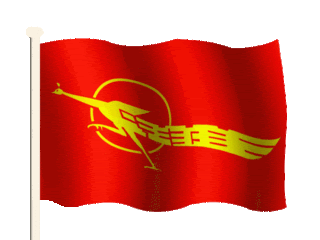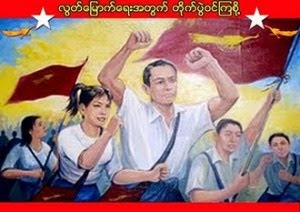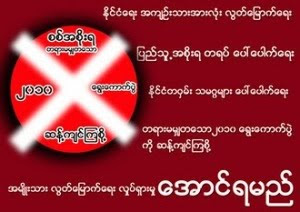After the end of the Cold World, the trend in military strategy and national security agenda has been changed all over the world from high politics which emphasized issues of war, nuclear deterrence to low politics which emphasized the environment, economic development and natural resources. Despite of this global trend, the Burmese Regime in Burma increased military spending for land warfare, sea power and air power while other countries are trying to reduce.
This essay will analyze the rise of military balance and its consequences.
According to the data of the International Institute for Strategic Studies (IISS), Burma military balance in 1987 and 2002 can be compared as
Total armed forces
19887:186,000 (personnel)
2002:444,000(personnel)
According to the data of the International Institute for Strategic Studies (IISS), Burma military balance in 1987 and 2002 can be compared as
Total armed forces
19887:186,000 (personnel)
2002:444,000(personnel)
army
1987:8 Regional commands
2002:12 Regional Commands
1987:8 Regional commands
2002:12 Regional Commands
Navy (patrols)
1987:36
2002:61
1987:36
2002:61
Air Force
1987:20 combat, no armed hel.
2002:113 combat,29 armed hel.
1987:20 combat, no armed hel.
2002:113 combat,29 armed hel.
So it is obvious that the defense sector of Burma has increased since 1988. Indeed, there are a variety of goals which countries try to increase the military power as an instrument. Payne categorized as
To prevent an invader from seizing one’s territory
To prevent an invader from taking away a part of one’s territory
To take away part of the territory of another country
To conquer another country (Payne, 1989:61)
To prevent an invader from seizing one’s territory
To prevent an invader from taking away a part of one’s territory
To take away part of the territory of another country
To conquer another country (Payne, 1989:61)
In the case of Burma, there has not been an invader or a threat to invader since 1988. So the rise of military power in Burma can be assumed as a threat to its neighbor countries.
Moreover, the prisoner’s dilemma can be used to analyze for arms racing between two countries.
Country B builds
More weapons
Country B doesn’t
Build weapons
Country A builds more
weapons
ARMS RACE
Country A attains
Military superiority
Country A doesn’t build
weapons
Country B attains
Military superiority
NO ARMS RACE
By using this simulation, I then looked at the military balance of the neighboring countries of Burma as follows by comparing the total armed forces.
1987
2002
Thailand
756,000
306,000
Laos
55,500
29,100
India
1462,000
1298,000
Bangladesh
131,500
137,000
Burma
186,000
444,000
Moreover, the prisoner’s dilemma can be used to analyze for arms racing between two countries.
Country B builds
More weapons
Country B doesn’t
Build weapons
Country A builds more
weapons
ARMS RACE
Country A attains
Military superiority
Country A doesn’t build
weapons
Country B attains
Military superiority
NO ARMS RACE
By using this simulation, I then looked at the military balance of the neighboring countries of Burma as follows by comparing the total armed forces.
1987
2002
Thailand
756,000
306,000
Laos
55,500
29,100
India
1462,000
1298,000
Bangladesh
131,500
137,000
Burma
186,000
444,000
The above figures clearly show that only Burma has increased military power and arms racing compared to its neighbor countries. Other countries reduced or remained similar figures. According to the prisoner dilemma as shown above, we can conclude that Burma has become a threat to the security of other countries.
Nevertheless, increasing the military power also means increasing the military spending. There are a lot of social and economic consequences of military spending as Sivard claimed _
“Third World defense budgets have increased sixfold, but half of the population in those countries did not have safe water to drink” (Sivard, 1987:3)
“In developing countries as many as twenty percent of children borne die before their fifth birthday; yet those countries spend almost four times as much on arms as they do on health care” (Sivard, 1987:6)
“Third World defense budgets have increased sixfold, but half of the population in those countries did not have safe water to drink” (Sivard, 1987:3)
“In developing countries as many as twenty percent of children borne die before their fifth birthday; yet those countries spend almost four times as much on arms as they do on health care” (Sivard, 1987:6)
It is clear that the social welfare system can not be effective by buying more guns and the defense budget can have a serious effect to the economic development of a nation.
In addition, the current military regime used the word ‘security’ several times for its arms racing. If security is defined in a broader sense, it is the expectation that one will live in a full life, not one sitting on the guns. Security cannot be purchased by the high rates of military spending only. There are a lot of other social indicators for the security concept, for example, if the spending for arms goes up, so do poverty, diseases and suffering (Kegley, 1988:359) Poverty and military spending are closely linked as a positive correlation.
In addition, the current military regime used the word ‘security’ several times for its arms racing. If security is defined in a broader sense, it is the expectation that one will live in a full life, not one sitting on the guns. Security cannot be purchased by the high rates of military spending only. There are a lot of other social indicators for the security concept, for example, if the spending for arms goes up, so do poverty, diseases and suffering (Kegley, 1988:359) Poverty and military spending are closely linked as a positive correlation.
The following figure shows the defense economic data of Burma during it high rates of military balance period.
1986
2002
Debt (US $)
4.2 billion
5.6 billion
Defense budget (US$)
252.56 million
555 million
$1=K
7.1271
850 (not 8.5)
1986
2002
Debt (US $)
4.2 billion
5.6 billion
Defense budget (US$)
252.56 million
555 million
$1=K
7.1271
850 (not 8.5)
In conclusion, the high rates of military balance in Burma and its increasing budgets have caused a lot of social and economic consequences in Burma as well as a threat to international community as a whole.
Khin Ma Ma Myo (26/03/2006)
References
IISS, The Military Balance, 1987-1988
IISS, The Military Balance, 2002-2003
Writz, J. (2002) “A New Agenda for Security and Strategy”, in Writz,J., Baylis, J. & Gray, C. Strategy in a contemporary World: An Introduction to Strategic Studies, Oxford University Press, Oxford
Sandler, T & Hartley, K. (1995) The Economics of Defense, Cambridge surveys of economic literature, Cambridge
Payne, S. (1988) The Conduct of War, Basil Blackwell.
Sivard, R. (1987) World Military and Social Expenditures, Washington D.C
IISS, The Military Balance, 1987-1988
IISS, The Military Balance, 2002-2003
Writz, J. (2002) “A New Agenda for Security and Strategy”, in Writz,J., Baylis, J. & Gray, C. Strategy in a contemporary World: An Introduction to Strategic Studies, Oxford University Press, Oxford
Sandler, T & Hartley, K. (1995) The Economics of Defense, Cambridge surveys of economic literature, Cambridge
Payne, S. (1988) The Conduct of War, Basil Blackwell.
Sivard, R. (1987) World Military and Social Expenditures, Washington D.C


































